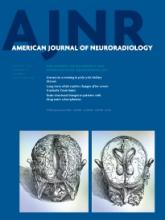Index by author
Gupta, R.
- FELLOWS' JOURNAL CLUBBrainOpen AccessLong-Term White Matter Changes after Severe Traumatic Brain Injury: A 5-Year Prospective CohortJ. Dinkel, A. Drier, O. Khalilzadeh, V. Perlbarg, V. Czernecki, R. Gupta, F. Gomas, P. Sanchez, D. Dormont, D. Galanaud, R.D. Stevens, L. Puybasset and for NICER (Neuro Imaging for Coma Emergence and Recovery) ConsortiumAmerican Journal of Neuroradiology January 2014, 35 (1) 23-29; DOI: https://doi.org/10.3174/ajnr.A3616
The authors used DTI to study posttraumatic white matter changes over a 5-year period. Thirteen patients with severe injuries acutely showed significant fractional anisotropy decreases in the corpus callosum and corona radiata when compared with controls. These abnormalities progressed at 2 years and then remained stable until 5 years. The DTI abnormalities correlated with sequelae such as amnesia, aphasia, and dyspraxia.
Hagemeier, J.
- EDITOR'S CHOICEBrainOpen AccessPrevalence of Radiologically Isolated Syndrome and White Matter Signal Abnormalities in Healthy Relatives of Patients with Multiple SclerosisT. Gabelic, D.P. Ramasamy, B. Weinstock-Guttman, J. Hagemeier, C. Kennedy, R. Melia, D. Hojnacki, M. Ramanathan and R. ZivadinovAmerican Journal of Neuroradiology January 2014, 35 (1) 106-112; DOI: https://doi.org/10.3174/ajnr.A3653
Healthy individuals who either had no relatives with multiple sclerosis or had a family history of it were studied and evaluated according the Okuda and Swanton criteria for radiologically isolated syndrome. These investigators found that the frequency of white matter signal abnormalities and radiologically isolated syndrome were higher in the healthy relatives of patients with multiple sclerosis compared with nonfamilial healthy control subjects. In healthy relatives of patients with MS, smoking and obesity also contributed to the presence of white matter lesions.
Hamberg, L.M.
- Head & NeckYou have access4D-CT for Preoperative Localization of Abnormal Parathyroid Glands in Patients with Hyperparathyroidism: Accuracy and Ability to Stratify Patients by Unilateral versus Bilateral Disease in Surgery-Naïve and Re-Exploration PatientsH.R. Kelly, L.M. Hamberg and G.J. HunterAmerican Journal of Neuroradiology January 2014, 35 (1) 176-181; DOI: https://doi.org/10.3174/ajnr.A3615
Han, M.-K.
- NeurointerventionYou have accessPotential for the Use of the Solitaire Stent for Recanalization of Middle Cerebral Artery Occlusion without a Susceptibility Vessel SignY.J. Bae, C. Jung, J.H. Kim, B.S. Choi, E. Kim, M.-K. Han, H.-J. Bae and M.H. HanAmerican Journal of Neuroradiology January 2014, 35 (1) 149-155; DOI: https://doi.org/10.3174/ajnr.A3562
Han, M.H.
- NeurointerventionYou have accessPotential for the Use of the Solitaire Stent for Recanalization of Middle Cerebral Artery Occlusion without a Susceptibility Vessel SignY.J. Bae, C. Jung, J.H. Kim, B.S. Choi, E. Kim, M.-K. Han, H.-J. Bae and M.H. HanAmerican Journal of Neuroradiology January 2014, 35 (1) 149-155; DOI: https://doi.org/10.3174/ajnr.A3562
Haseltine, J.
- BrainOpen AccessDoes the Location of the Arterial Input Function Affect Quantitative CTP in Patients with Vasospasm?B.J. Shin, N. Anumula, S. Hurtado-Rúa, P. Masi, R. Campbell, R. Spandorfer, A. Ferrone, T. Caruso, J. Haseltine, C. Robinson, A. Gupta and P.C. SanelliAmerican Journal of Neuroradiology January 2014, 35 (1) 49-54; DOI: https://doi.org/10.3174/ajnr.A3655
Hernandez, M.C. Valdés
- EDITOR'S CHOICEBrainOpen AccessMorphologic, Distributional, Volumetric, and Intensity Characterization of Periventricular HyperintensitiesM.C. Valdés Hernández, R.J. Piper, M.E. Bastin, N.A. Royle, S. Muñoz Maniega, B.S. Aribisala, C. Murray, I.J. Deary and J.M. WardlawAmerican Journal of Neuroradiology January 2014, 35 (1) 55-62; DOI: https://doi.org/10.3174/ajnr.A3612
These authors sought to characterize white matter lesions of elderly adults and determine if some were artifacts. Using FLAIR they imaged 665 subjects without dementia, carefully measured and evaluated periventricular white matter lesions, and correlated these with several aspects of cardiovascular disease. They concluded that periventricular white matter hyperintensity levels, distribution, and association with risk factors and disease suggest that in old age, these are true tissue abnormalities and therefore should not be dismissed as artifacts.
Hiwatashi, A.
- BrainOpen AccessEvaluation of Diffusivity in the Anterior Lobe of the Pituitary Gland: 3D Turbo Field Echo with Diffusion-Sensitized Driven-Equilibrium PreparationA. Hiwatashi, T. Yoshiura, O. Togao, K. Yamashita, K. Kikuchi, K. Kobayashi, M. Ohga, S. Sonoda, H. Honda and M. ObaraAmerican Journal of Neuroradiology January 2014, 35 (1) 95-98; DOI: https://doi.org/10.3174/ajnr.A3620
Hoang, J.K.
- SpineYou have accessOptimal Contrast Concentration for CT-Guided Epidural Steroid InjectionsP.G. Kranz, M. Abbott, D. Abbott and J.K. HoangAmerican Journal of Neuroradiology January 2014, 35 (1) 191-195; DOI: https://doi.org/10.3174/ajnr.A3626
Hojnacki, D.
- EDITOR'S CHOICEBrainOpen AccessPrevalence of Radiologically Isolated Syndrome and White Matter Signal Abnormalities in Healthy Relatives of Patients with Multiple SclerosisT. Gabelic, D.P. Ramasamy, B. Weinstock-Guttman, J. Hagemeier, C. Kennedy, R. Melia, D. Hojnacki, M. Ramanathan and R. ZivadinovAmerican Journal of Neuroradiology January 2014, 35 (1) 106-112; DOI: https://doi.org/10.3174/ajnr.A3653
Healthy individuals who either had no relatives with multiple sclerosis or had a family history of it were studied and evaluated according the Okuda and Swanton criteria for radiologically isolated syndrome. These investigators found that the frequency of white matter signal abnormalities and radiologically isolated syndrome were higher in the healthy relatives of patients with multiple sclerosis compared with nonfamilial healthy control subjects. In healthy relatives of patients with MS, smoking and obesity also contributed to the presence of white matter lesions.








